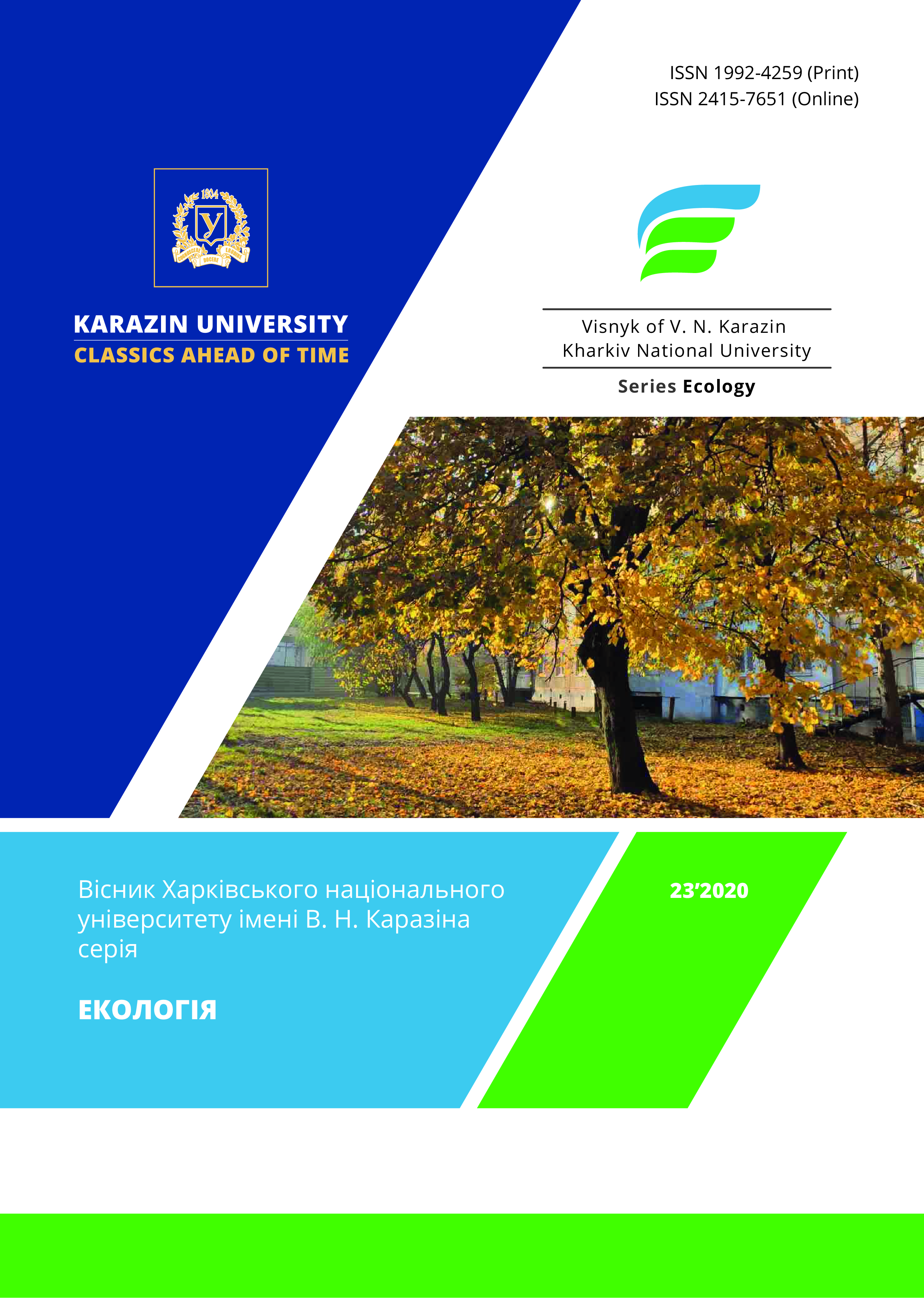Ecological Condition of the Sapalayivka River in the Conditions of Lutsk Urbosystem
Abstract
Purpose. Determination of the main factors of anthropogenic impact of the urban system of the city of Lutsk on the river basin of the river Sapalaivka and assessment of the ecological condition of the river on the basis of MIR "Macrophytic index of rivers".
Methods. Comparative-geographical, generalization, systematization, statistical, comparative-analytical, descriptive, cartographic.
Results. In the Sapalaivka River, 21 indicator species of macrophytes were found in the surveyed test areas, among which - 8 plants belong to dicotyledons, and 13 plants belong to monocotyledons, using which the
MIR values were calculated. Depletion of macrophyte species composition from 15-16 in test plots 1 and 2 to 2 species in test plot 3 indicates deterioration of the ecological condition of the river and the emergence of unfavorable conditions for macrophyte habitats. On the territory of the city, the section of the Sapalaivka riverbed, from the beginning of Potapova Street to the mouth, is mostly canalized, the species composition of macrophytes is depleted here and there is a specific smell of sewage. The part of the river that flows in the city (before Potapova Street), which was renaturalized in 2012-2016, has a richer species composition of macrophytes. Outside the city, the Sarpalaivka river basin is in good condition, as evidenced by the species composition of flora and fauna, as well as the intensive development of higher aquatic vegetation.
Conclusion. As a result of the calculated ecological index of macrophytes MIR it is established that the water quality in the river Sapalaivka on the test site № 1, belongs to the II class, category - good and by trophic status is mesotrophic; on the test site № 2, belongs to the III class, category - satisfactory and eutrophic in trophic status; on the test site № 3, belongs to class IV, category - poor and trophic status is polytrophic. It is advisable to carry out further environmental measures, especially in the lower reaches of the river, in order to eliminate sources of water pollution, and to monitor the ecological status of the reservoir in order to restore the species composition of macrophytes and the ability to self-clean.
Downloads
References
Molchak, Ya.O., Fesiuk, V.O. & Kartava, O.F. (2003). Lutsk: current ecological condition and problems. Lutsk: RVV LSTU. (In Ukrainian).
Mirach, P.S., Shakh, V.M. & Kondratiuk, H.M . (1994). Passport of Sapalaivka river. Rivne: Joint-stock company institute "Volynvodproekt". (In Ukrainian).
Zabokrytska, M. R. & Khilchevskyi, V. K. (2016). Lutsk water bodies: hydrography, local monitoring, wa-ter supply and drainage. Hydrology, hydrochemistry, hydroecology. t.3(42) .63-76. Retrieved from http://nbuv.gov.ua/UJRN/glghge_2016_3_9 (In Ukrainian).
Boiaryn, M. Lavreniuk, Z., Muzychenko, O. & Savchuk, L. (2013). Analysis of the ecological condition of the Sapalaivka river basin. Scientific Bulletin of the Lesia Ukrainka East European National University. Geographical sciences. (16), 201-205. Retrieved from http://nbuv.gov.ua/UJRN/Nvvnug_2013_16_31
Nychaia, O.O., Melniichuk, M.M. & Tarasiuk N.A. (2012). Geoecological rehabilitation of Lutsk rivers (on the example of Sapalaivka river). Proceedings of the II scientific-practical. conf. : State and Prospects of Innovative Development of the City of Lutsk. Lutsk: Eastern European Nation. Univ. Lesya Ukrainka, 98 -102. (In Ukrainian).
Korobkova, H.V. (2017). Use of macrophytic indices to assess the ecological status of surface waters of Ukraine. Man and the environment. Problems of Neoecology, ( 1-2 (27)), 62-70. (In Ukrainian).
Boiaryn, M.V. & Netrobchuk, I.M. (2016). Fundamentals of hydroecology: theory and practice. Tutorial. Lutsk: Vezha-Druk. Retrieved from http://esnuir.eenu.edu.ua/handle/123456789/11832 (In Ukrainian).
Ciecierska, H. & Maria Dynowska, M. (2013). Biological methods of assessing the state of the environment. Volume 2. Water ecosystems. Methodical handbook. Olsztyn. Retrieved from https://docplayer.pl/1480006-Podrecznik-metodyczny.html (In Poland).
AFNOR (Assosiation Francaise de Normalisation) Qualite de l’eau – Determination de l’indice biologique macropfytique en rivier (IBMR) – Norm francaise NFT (2003). 90 – 395. (In Poland).
Szoszkiewicz, K., Karolewicz, K., Lawniczak, A. & Dawson, F. (2002). An Assessment of the MTR Aquatic Plant Bioindication System for Determining the Trophic Status of Polish Rivers. Polish Journal of Environmental Studies, 11(4), 421-427. Retrieved from https://www.researchgate.net/publication/239752359_An_Assessment_of_the_MTR_Aquatic_Plant_Bioindication_System_for_Determining_the_Trophic_Status_of_Polish_Rivers
Tsos, O.O. (2013). Environmental assessment of surface water quality of the river Turia. The Nature of Western Polissya and Adjacent Territories,(1), 69 – 74. (In Ukrainian).
Tsos, O.O. (2013). Indication flora of the river Turia. Visnyk of VN Karazin Kharkiv University Series “Ecology”, 14, 71-77. https://doi.org/10.26565/1992-4224-2018-30-08 (In Ukrainian).
Tsos, O.O. (2017). Ecological assessment of surface water quality of the Tsyr River by categories. Man and the environment. Issues of neoecology, (1-2 (27)), 71-76. Retrieved from https://periodicals.karazin.ua/humanenviron/article/view/9172 (In Ukrainian).
Tsos, O.O., Muzychenko, O.O. & Boiaryn M.V. (2018). Structural analysis of higher aquatic and coastal aquatic plants of the Vyzhivka river. Man and the environment. Problems of neoecology, (30), 104-111. https://doi.org/10.26565/1992-4224-2018-30-08 (In Ukrainian).
Boiaryn, M. & Tsos, O. (2019). Assessment of the ecological status of the Turia River surface waters on the basis of the River Macrophyte Index (MIR). Chemia. Envirinment. Biotechnology, 22, 7-12. http://dx.doi.org/10.16926/cebj.2019.22.01) (In Poland).
EU Water Framework Directive 2000/60/EC. Official Journal of the European Communities, 22.12.2000. L 327 / 1. Retrieved from https://ec.europa.eu/environment/water/water-framework/index_en.html (In Holland).
Authors who publish with this journal agree to the following terms:
- Authors retain copyright and grant the journal right of first publication of this work under the terms of a license Creative Commons Attribution License 4.0 International (CC BY 4.0).
- Authors are able to enter into separate, additional contractual arrangements for the non-exclusive distribution of the journal's published version of the work (e.g., post it to an institutional repository or publish it in a book), with an acknowledgement of its initial publication in this journal.
- Authors are permitted and encouraged to post their work online (e.g., in institutional repositories or on their website) prior to and during the submission process, as it can lead to productive exchanges, as well as earlier and greater citation of published work.





